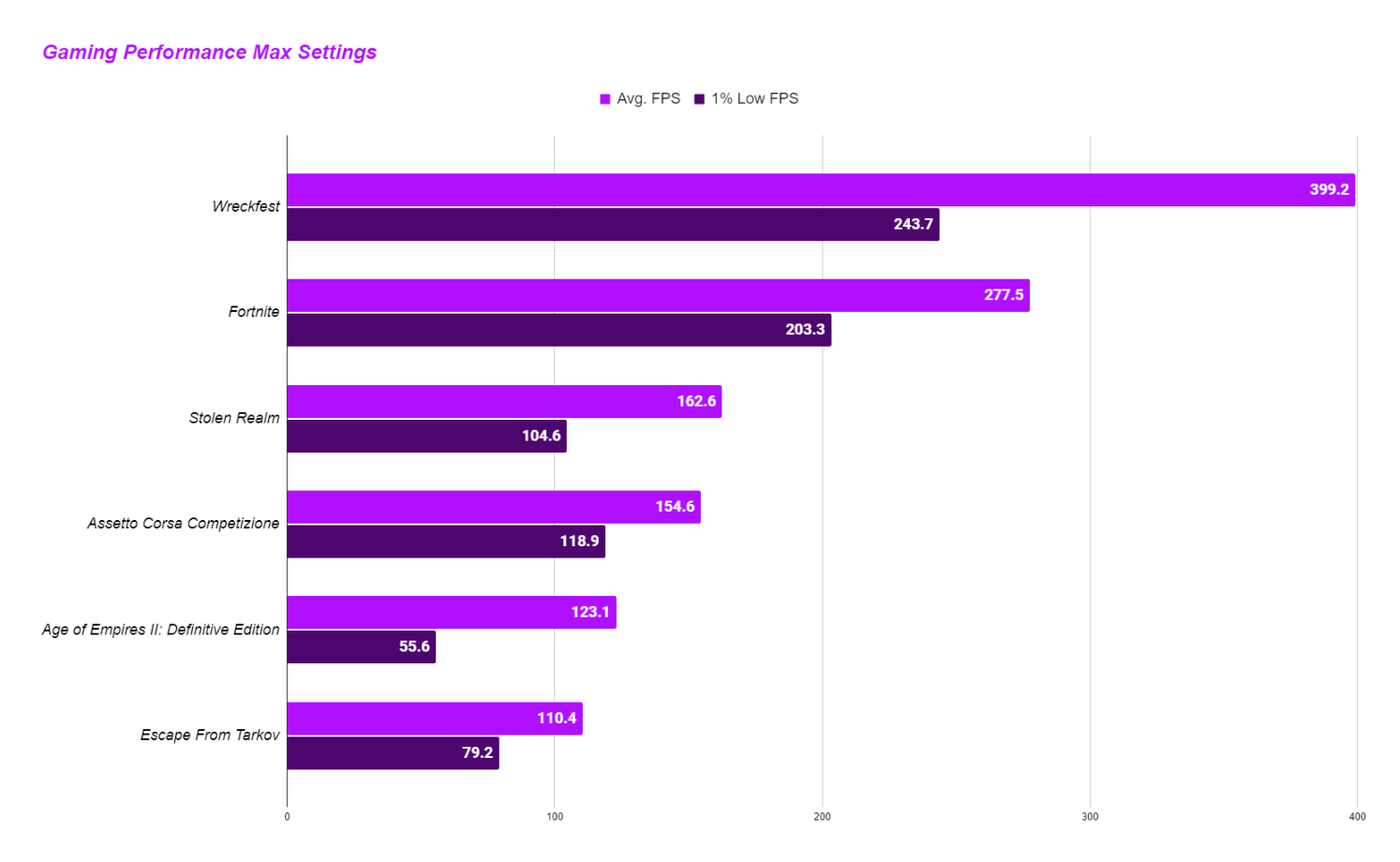For the last few years, Intel has had to deal with tougher competition than ever from AMD. Team red has put out impressive CPUs like the Ryzen 7 7800X3D and Ryzen 9 7950X that are forcing Intel to really push the boundaries of what it can do while still being affordable for consumers. While the Intel i9-14900K CPU isn’t a complete jump into the next generation – there’s no core count increase at all compared to the 13900K – it’s still a competitive CPU with some boosts that Intel hopes justifies those looking for an upgrade.
The main question, and one we plan to answer, is whether the performance increases are worth the added power consumption and heat.
The i9-14900K offers 24 cores and 32 threads as well as 8 P-cores and 16 E-cores1. It has a base clock of 3.2 GHz with a boost clock of 6 GHz that can regularly be hit stably, depending on your machine. But more on that later.
The latest flagship CPU from Intel keeps the same LGA 1700 socket, allowing people to upgrade without having to purchase a new motherboard with it. That is, of course, you’ve purchased an Intel CPU over the last couple of years.
The CPU may have launched back in October, but it’s still the top CPU Intel has to offer consumers. But is it really worth picking even with a slightly lower price than the $589 it released at?
| Specification | Details |
|---|---|
| Architecture | Raptor Lake |
| Cores | 24 (8 P-cores/16 E-cores) |
| Threads | 32 |
| Base Clock | 3.2 P-core/2.4 E-core (GHz) |
| Max Clock | 6/4.4 GHz |
| Socket | LGA 1700 |
| Process | 10nm |
| L3 Cache | 36mb |
| L2 Cache | 32mb |
| Price | $590 launch/$550 average now |
Benchmarks
Before getting into the actual review, let’s talk about what we’re working with here hardware wise.
Obviously, the CPU is the Intel i9-14900K. It’s sitting in a MSI MPG Z790 Carbon Max WiFi motherboard with 32GB of Trident Z5 DDR5-8000 RAM and a Nvidia RTX 4090 FE. For cooling the CPU, we’re using the Corsair H150i iCue Link LCD AIO along with six iCue Link fans. The entire PC is sitting in a Corsair iCUE 5000D RGB Airflow ATX mid-tower case.
Now, I’ve never been one to only want to spit out a bunch of numbers when reviewing hardware. However, testing how games and software performs with any hardware is still an important part of the process even if it’s not the only part.
To perform synthetic benchmarking Cinebench 2024, PCMark 10, Geekbench 6, Blender, and 7-Zip Compression were all used. Overall, the numbers were as good as you’d expect from a modern-day high-end PC2.
| Benchmark | Results |
|---|---|
| Blender | 7:31 Render Time |
| 7-Zip Compression | 193,600 MIPS |
| Geekbench 6 Multi-Core | 19511 |
| Geekbench 6 Single-Core | 2974 |
| Cinebench 2024 Multi-Core | 2055 |
| Cinebench 2024 Single-Core | 130 |
| PCMark 10 | 14,077 |
With Blender, we were able to render the Scanlands demo file in just 7:31. Running compression benchmarking saw the CPU hit 193,600 MIPS. For comparison sake, it came in above the average score of 185,000 MIPS that the Ryzen 9 7950X.
Geekbench 6 results came with a multi-core score of 19511 and single-core score of 2974. To get these scores, Geekbench 6 looks at various processes like web browsing, file compression, ray tracing, and more.
In Cinebench 2024, multi-core performance came in at 2055, putting it above the AMD 7950X, 5950X, 7950X3D, and i9-13900K. At single-core, it had a score of 130, scoring better than the i9-13900k, AMD 7950X, 5950X, and 7950X3D.3
Day to Day Usage
While the standard benchmarking performances for the i9-14900K were good, it really comes down to how it performs under realistic situations.
When buying a new CPU and building out a new PC, it’s highly unlikely that you’re going to be doing just one thing with it. More than likely, it’s going to be your daily driver where you’ll game, work, and more.
Since building this machine, the goal of mine was to use it as my only PC. Whether it was to play games like Escape From Tarkov or Age of Empires II Definitive Edition to building websites to editing videos and creating graphics, I wanted to put the i9-14900K through all of its paces. Leave no stone unturned, if you will.
I’ve spent the last two months putting this CPU through everything I could think of, and it’s safe to say that the CPU was able to handle everything thrown at it without ever really breaking a sweat. While that does have a lot to do with the cooling you have in your machine, if the CPU isn’t powerful enough, the cooling really won’t matter.
For those who like specific numbers, don’t worry. We have plenty to get to with each game, no matter the type, hitting impressive numbers on the test bench.

Productivity wise, I used the CPU to render multiple videos within Davinci Resolve and measured the time it took to complete. For a 10-minute 1080p60 video, it completed in 2:29; at 1440p, it completed in 4:20; rendering 4K took the longest, but it still finished in a rather quick 8:18.
I mentioned earlier that the i9-14900K CPU advertises a max boost clock of 6 GHz. When overclocking, I found I was able to reliably hit 5.4-5.9 GHz without issue no matter what I was doing. Gaming, video editing, compiling, it didn’t matter. Everything ran as expected when running at the higher clock speeds. One thing to note, though, is that if you don’t know what you’re doing with overclocking, don’t attempt it. There are plenty of great guides online if you really want to get into it, just be careful so you don’t damage any of your components.
Moving on to a major point of contention for many, let’s talk about temperatures and power consumption. Overall, the CPU stayed relatively cool when working or playing throughout the day. For power usage, that was more of a mixed bag.
During general usage, it would max out around 176-180W with an average of 78W when doing simple things like browsing, checking emails, and even writing this review.
RELATED: Should You Buy An Nvidia RTX 4070 Graphics Card?
At its peak, the i9-14900K hit wattages of 336W when running the various synthetic benchmarks. Overall, it did bounce around, however, never settling around a single temperature range. The highest it ever got is 646.41W for a split second when running the PCMark10 Extended Benchmark. The number stands out and should be mentioned, but it’s not one you should really worry about due to it not representing what you’ll mostly be doing on your machine.
When gaming, the power consumption would get up to a max of 304W with an average of 210W. During video rendering, the max would get to 285W for 4K60 videos.
As mentioned early, having a solid cooler for your CPU is going to go a long way to keeping temperatures down. That said, there was quite the variance in thermals with the i9-14900K CPU when testing for this review.
On average, the CPU bounced between 45°C-60°C. At its peak, though, the temperatures would get up to 108°C during heavy rendering or benchmarks.

Intel i9-14900K CPU Review Final Verdict
The Intel i9-14900K is a powerful CPU that has made gaming and working so much faster and more efficient. Working with it daily, you’ll find that everything you can think of doing can easily be done without any real effort or strain on your machine. Especially if you are pairing it with a high-end GPU or motherboard.
If you have a newer CPU, say an AMD Ryzen 7 or 9 or a recent Intel i7 or i9, this upgrade likely isn’t going to be worth it for the cost, power consumption, and slight performance boosts. Also, it’s not likely to be a CPU for you if you don’t plan on running a high-end graphics card along with it as you can still get solid performance from a mid-range i5-14600k alongside, say, an Nvidia RTX 4070 GPU or AMD RX 7800 XT.
That said, if you haven’t made the jump to a machine with DDR5 memory and PCIe 5.0, there’s really no better time than now to get your new build up and running. It’s a high-powered CPU that, when paired with a good cooler, motherboard, and graphics card, will leave you with a reliable and high-end build for years for all of your gaming, streaming, recording, and more.
- P-cores are Performance cores made to deliver at more intense workloads while E-cores are Efficiency cores made to keep the system running, well, efficiently, during regular usage. ↩︎
- The benchmarks used for these review are done based on recommended settings. Your use will likely vary with numbers. These numbers should not be taken as 100% certainty, and should just be used to help make your purchase decision. ↩︎
- The comparisons come via testing of prior CPUs from the reviewer. ↩︎










